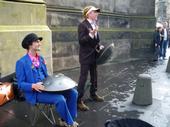"Long ago we humans used a form of communication
and sensing that did not involve the brain in any way;
rather it came from a sacred space within our Heart."
This is what Wickipedia says about The Hang (Musical Instrument)
A Hang [hun] (pronunciation between the vowel sounds in the word 'Hot' and 'Hungry') is a melodious percussive steel musical instrument created in Switzerland. It uses some of the same physical principles as a steel drum. That being said there has been much metallurgical and acoustic research by the makers which have led to significant changes in structure, design, and process. Along with those differences the Hang is generally played with the hands and fingers instead of mallets, so the sound is generally softer and 'warmer'. The notes can sound like a harp, bells, or harmonically tuned steelpans with many overtones built into each note. The instrument has sometimes been referred to by owners and others as a hang drum, because it is often played like a drum, its relation to the steel drum, and its popularity with hand drummers. While this is true, there are other ways to coax sound out of a Hang that do not involve 'drumming'.
The Hang is typically played resting on the player's lap, and can also be played on a stand. It was the result of many years of research on the steelpan and the study of the diverse collection of instruments from around the world, such as gongs, gamelan, ghatam, drums, bells, etc. Udu-like sounds can be produced with the Helmholtz resonance that can occur within the clamped shallow shells. It also has the capacity to ring like a singing bowl.
The Hang was developed in 2000 in Berne, Switzerland by Felix Rohner and Sabina Schärer (PANArt Hangbau AG) and introduced at the Frankfurt Music Fair in 2001. Its name comes from the Bernese German word for hand. The two deep drawn steel hemispheres are hardened by a process known as gas-nitriding. The side considered the 'bottom' has an opening (Gu) in the center which is the bass note. When it is played in a dampened way it can change in pitch similar to a talking drum. On the 'top' are seven (in the bass version of the Hang) or eight (treble version) notes arranged in a 'Tone Circle' in zig-zag fashion from low to high. All are tuned harmonically around a low note (Ding) at the center of the Tone Circle.
There are only two people who make Hanghang (plural form of Hang), the inventors Felix Rohner and Sabina Schärer. They have a little workshop in Berne where every Hang in existence was made. In 2006 the Hang Makers stopped shipping instruments directly and halted sales through retailers. To obtain a Hang, prospective customers must now send a letter to request an instrument. Worldwide offers for used Hanghang are rare, and prices in Internet auctions have been exceptionally high due to an increased demand since 2006 and a reduction in supply due to changes in the manufacture and distribution of Hanghang.
In the spring of 2006 the Hang Makers presented a new generation of Hanghang. The new instruments (often referred to as 2nd Generation) have a surface coating of annealed brass over the nitrided steel as well as a ring of brass around the circumference of the Hang. Older Hanghang had tone fields with the oval indentation oriented radially towards the Ding, with the 2007 models (as well as the Integral Hang) the tone fields are angled at about 45° from a line drawn from the Ding to the edge. They also started marking the individual serial number on the inside of the Gu opening and signing each Hang at the outside edge of the Gu side of the Hang.
In the spring of 2008 the Hang Makers presented a new Hang referred to as the Integral Hang. Numbers began again with an H in front (H1, H2, etc.) and it appears the first were created in November of 2007. Several changes mark the Integral Hang. It now has only one scale (D3 Ding, A3, Bb3, C4, D4, E4, F4, A4). While the circumference remains a circle, the Gu side has been shaped very slightly as an oval from the spherical. Along with that shift, the Gu hole is now a subtly oval shape which creates two Gu ringing 'notes' - F and an F. Significant changes have been made to the Ding (center note on the top). It now has a circular indentation in the dome and has a texture of brass applied, annealed, and then lacquered. The PANArt logo, serial number, date of finalization, and signatures of the Hang Makers are now on Gu side of the Hang near the equator where the two shells meet.
............................................................
...................................
Daniel had been introduced by his close friend Chris Large to the Hang Instrument (*thankyou chap*) sometime in 04.
Danny had met the instrument at the Fire Gathering 05.
They met each other at a few festivals during the summer of June 06...
They then both travelled to Switzerland seperatly in September 06 to find their instruments...
When both had returned to England with their choosn tunnings, it soon became apparent that they that the vibrations of Hang playing would amplify with much more resonance if they were being played in warmer airs...
Currently the Hedge Monkeys are scouting for new territories and play friends :-)
